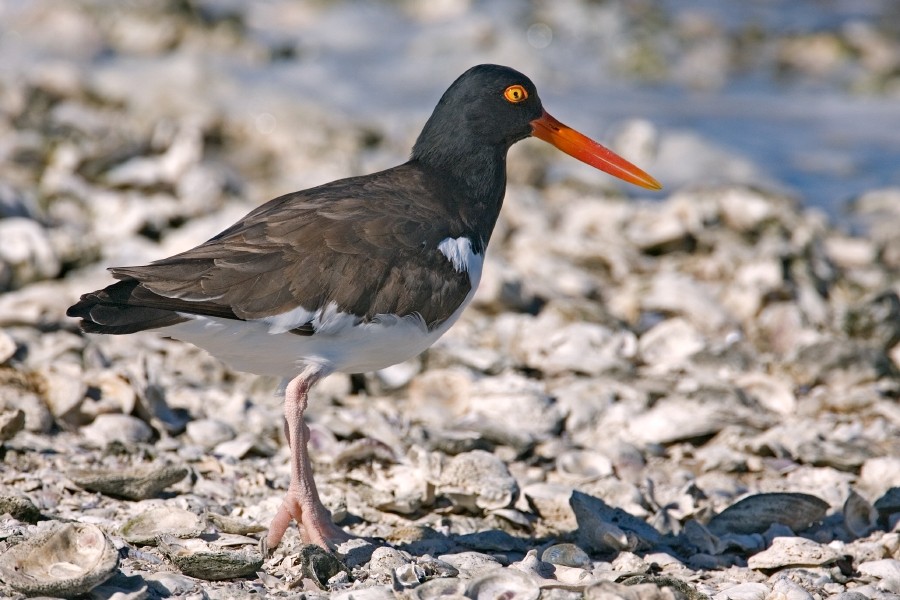American Oystercatcher
A species of Oystercatchers Scientific name : Haematopus palliatus Genus : Oystercatchers
American Oystercatcher, A species of Oystercatchers
Botanical name: Haematopus palliatus
Genus: Oystercatchers
Content
Description People often ask General Info
 Photo By Alan D. Wilson, www.naturespicsonline.com , used under CC-BY-SA-2.5 /Cropped and compressed from original
Photo By Alan D. Wilson, www.naturespicsonline.com , used under CC-BY-SA-2.5 /Cropped and compressed from original Description
The American oystercatcher has distinctive black and white plumage and a long, bright orange beak. The head and breast are black and the back, wings and tail greyish-black. The underparts are white, as are feathers on the inner part of the wing which become visible during flight. The irises are yellow and the eyes have orange orbital rings. The legs are pink. Adults are between 42–52 cm (17–20 in) in length. 
Size
43 - 53 cm
Colors
Black
Gray
White
Life Expectancy
17 years
Nest Placement
Ground
Clutch Size
2 - 4 eggs
Incubation Period
1 brood
Number of Broods
24 - 28 days
Feeding Habits
American Oystercatcher's diet primarily consists of saltwater bivalves like clams, oysters, and mussels, occasionally consuming limpets, jellyfish, starfish, marine worms, and crabs. They forage by snipping or smashing shells to sever the bivalves' adductor muscles, with techniques varying among individuals. Tidal conditions dictate foraging timing, favoring falling tides. American Oystercatcher also probes sand for buried prey like mole crabs and worms.
Habitat
American Oystercatcher typically inhabit coastal regions, favoring sandy or shelly beaches, salt marshes, and intertidal zones with mudflats. They are also found in barrier islands, marsh islands, and dredge spoil islands comprised of sand or gravel. During breeding, they select areas with minimal predatory threats and may nest in sandy spots in salt marshes or on vegetation mats. In migration and winter, they remain in similar intertidal habitats, feeding in areas exposed by tides. Harsh weather drives them to seek refuge in nearby open habitats, such as agricultural fields.
Nest Behavior
The female american Oystercatcher selects the site and lays eggs in the scrape, with the timing and parental care being consistent with typical shorebird patterns involving both parents in incubation and chick rearing.
Nest Characteristics
American Oystercatcher's nest is a scrape in the sand found in vegetation on barrier beaches, shelly islands, or high marsh, often among dune vegetation like sea oats or beach grass, and sometimes on gravel rooftops or artificial islands.
Dite type
Aquatic invertebrate eater
People often ask
General Info
Feeding Habits
Bird food type
Sounds
Call
Recording location: Chile
Call
Recording location: Chile
Behavior
American Oystercatcher exhibit monogamous behaviors, often forming enduring pair bonds. They engage in an animated courtship ritual known as the Piping Ceremony, which involves synchronized sand pacing, piping calls, and flight. This species occupies territories up to 5.3 acres, sometimes within other bird colonies. Both genders share the responsibilities of incubation and defense. Notably, american Oystercatcher are known to dive and swim to evade predators. Post-breeding, families disperse, with juveniles sometimes remaining distant for years before returning.
Distribution Area
The American oystercatcher is found on the Atlantic coast of North America from New England to northern Florida, where it is also found on the Gulf coast, the Caribbean, and south to Brazil, Uruguay and Argentina. It is found also in the Pacific coast of California, Mexico, Central America, Peru, and Chile. In the 19th century they became locally extinct in the northeast of the United States due to market hunting and egg collecting. After receiving protection under the Migratory Bird Treaty Act, their range extended northward to re-occupy historical habitat in New England. During the breeding season, these birds are found along the Atlantic and Gulf Coasts and from Massachusetts south to Argentina and Chile. In winter, they are found in flocks along the coast from central New Jersey to the Gulf of Mexico. 
Species Status
Not globally threatened.

 Photo By Alan D. Wilson, www.naturespicsonline.com , used under CC-BY-SA-2.5 /Cropped and compressed from original
Photo By Alan D. Wilson, www.naturespicsonline.com , used under CC-BY-SA-2.5 /Cropped and compressed from original Scientific Classification
Phylum
Chordates Class
Birds Order
Shorebirds Family
Oystercatchers Genus
Oystercatchers Species
American Oystercatcher